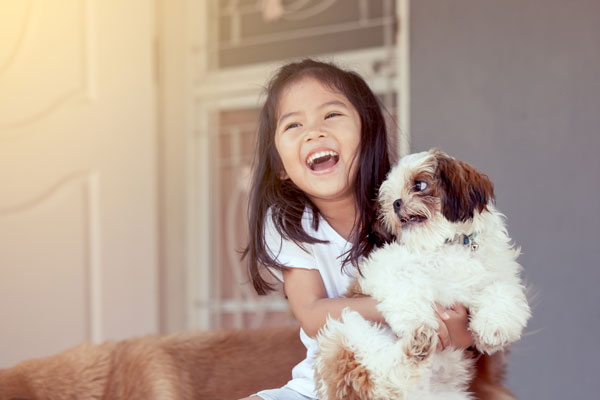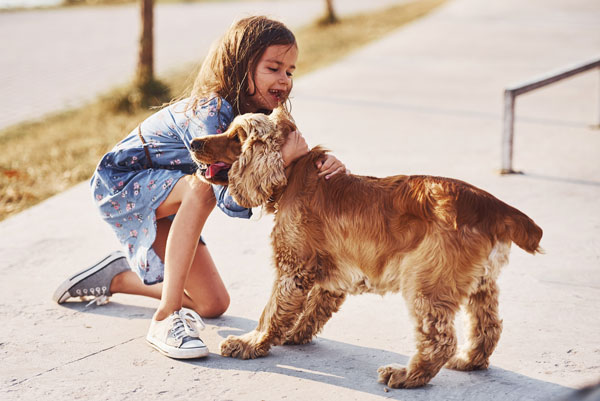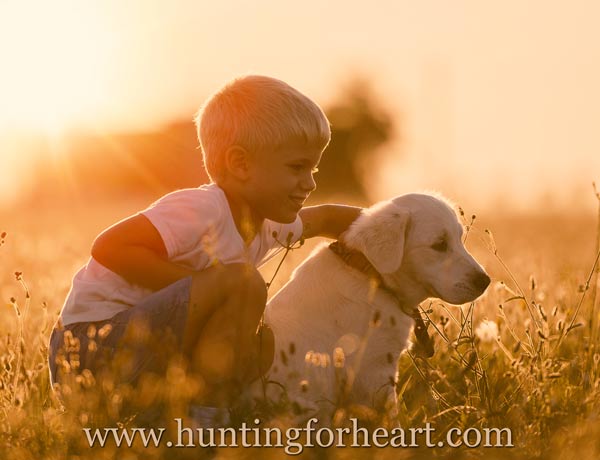How to Prevent Dogs Biting Kids
by Ellen Landauer
Dogs biting kids: Do you know that over 75 percent of such injuries are inflicted by either the family pet or that of a friend or relative?
Yes, these incidents mostly involve an animal that is already familiar and friendly with the child!

Commonly, loving parents have photographed the pups involved, with kids bear-hugging and kissing them, carrying them from room to room, sitting on them, dressing them up in doll clothes, etc.
Everyone (except the pup) sees this as 'cute.'
None of those activities are things our canine pets particularly want to do - and really would rather not. (Rarely, if ever, do you see similar photos of children and cats - we all know how that would go! Cats don't have anywhere near the capacity to restrain their aggression as dogs usually do)!
Parents look on and say, 'Isn't it wonderful how Fluffy lets the children do ANYTHING to her (puts up with them)! She's always so GOOD with them!'
Such an attitude is bad for everyone, the children, the dogs and parents.
Why??
Dogs Biting Kids: Everyone Suffers
THE CHILDREN:
Dogs biting kids becomes a real possibility when children are taught it is OK to treat a canine pet as a THING, a TOY - rather than being shown how to have empathy and respect for their pet. The dogs' true nature is being ignored and their energy repressed rather than channeled - by having to put up with abusive behavior - however well-meant it may be.
Repressed energy becomes increasingly dangerous the more it accumulates. Good intentions don't count for an animal suffering from emotional overload.
When children are taught that living beings are toys to be trifled with, they are in potential danger due to that trifling.
__________________________________
PHOTO BELOW: The little girl is happy and has no idea how her Shih Tzu puppy is feeling. Look at the pup's eyes and mouth; he is afraid.

Dogs biting kids will be largely prevented by grown-ups taking a pro-active approach to supervising and teaching children.
Parents are shortchanging their child's emotional development if they do not raise them to honor their pets' needs. Putting their pet's needs before their own whims and impulses teaches a child to be a better person. A child not mentored in these things can mature into a grown-up more selfish and less compassionate, attuned, and understanding than they would have been. When children are taught to be emotionally sensitive to the needs of their pet, it benefits everyone.
_______________________________
A PERSONAL EXPERIENCE:
'I remember as though it were yesterday, an incident when I was a mere toddler. I was out on the patio and saw a sparrow hopping about maybe 12 feet away.
With no malice, just childhood curiosity and desire to make contact with the bird, totally innocent - I picked up a stone and threw it at the sparrow.
'In seconds, my Dad was by my side. He took my hand and spoke to me. He said that throwing the rock at the bird had 'hurt its feelings.' He spoke in a way that somehow got through to me that the bird had experienced hurt by my action.
Dad's fast response expressed that this was important. His caring way of speaking evoked feeling in me. I felt profound sadness, and tears rolled down my face.
'I never forgot. That was my first lesson in having compassion for other species.'
______________________________
If the family pet is killed because they bit a child, the children are learning that even the life of a beloved is expendable. They are being shown that it's acceptable to end the life of a devoted, loving creature as soon as it scares someone by growling, or hurts by nipping or biting. Worse, the life of an innocent, loving pet is destroyed! How is this going to impact the child's future relationships?
Additionally, once such a decision is made, the grown-ups and children involved usually suffer - conflict, guilt, heart-wrenching grief, emotional emptiness. When the decision is made to 'put down' (KILL) this creature, on some level the humans involved finally may admit to the love and innocence within their once beloved companion - that was somehow missed when fear ruled.
With all the concern over 'cruelty to animals,' it is beyond understanding how fast some people will kill their dogs - with the agreement of the veterinarian who performs the execution!
The other option - giving the dog away to be adopted - burdens others with an animal that has acquired behavior problems. Families that give up dogs with any history of biting commonly don't inform the shelter or foster home of such things.
For four years, I did volunteer work at an animal shelter and saw this firsthand. One of the staff, a woman who took care of most admissions to the shelter talked about this with me one day. She described instances where families told her the dog was 'good with children,' safe, well-behaved - and the first thing the animal did as she was handed the lead was explode in rage and try to bite her! She would lift up on the leash, looking straight at the people surrendering the dog saying, 'You didn't tell me about THIS!'
The reason for not disclosing vital information can be deep guilt. Those giving up the dog want to make sure it is accepted into the adoption program and finds a new home. That way they can feel less guilty.
______________________________
IMPORTANT NOTE: In recent years, it has become risky to adopt any but the most benign temperament dogs. Far too many 'rescue' organizations are passing on truly dangerous dogs, many of them pitbulls or mixes.
Code words for seriously dog-aggressive, or child-aggressive rescues - many of whom have been returned from previous adopters include 'must be only pet,' 'only for families with older children,' 'chronic overarousal,' 'dog needs to decompress,' etc. (1)
Deceptive advertising puts people and their pets at serious risk (2)
______________________________
THE DOGS:
The 'tolerance' pups show for ignorant abuse is simply subtle avoidance resulting from fear. Turning eyes and head away, leaning away, licking their lips, panting with lips drawn back tight (no, it's not a 'smile'), whites of eyes showing - are early indications that this animal is feeling compressed and smothered. They are SUFFERING.
Any of the above early warning signs should immediately prompt a parent or other adult on the scene to decisively intervene, take the child by the hand and away from the dog (who likely will want to move off to a sheltered spot to feel safe).
When a dog feels smothered, they experience it as feeling you pressing in on them, like walls closing in.
Terror of the trap arises because in the wild, when an animal is restrained and can't move, it usually is in a situation where death is imminent. This is built in to all animals.
Spoiled pets that are smothered with love in the hope this will make them happy - are not - they are stressed. Think how you would feel if someone solicitously hovered over you night and day - if you are a balanced person, this would drive you crazy! At some point, you would lash out and tell the smotherer to leave you alone!
When your pet reaches the point where they growl, nip or bite hard - they don't even know who you are! All they know is they feel the terror of the trap, which in the wild bespeaks impending death - and their spark of life ignites to try and save them. All the while, the humans think they are 'loving' their pet by a tight hug that never ends, or a big kiss right in the middle of the dog's face. They are shocked and fearful if aggression arises - with no clue that it was the uninformed behavior of the humans that triggered it.
By the way, when vet techs put a dog in an arm lock to restrain them, the same survival instincts arise. Kevin Behan told me of various instances of serious aggression problems originating at a vet's office!
If the puppy was a pony, responsible parents would explain in no uncertain terms that the child should NEVER suddenly approach the pony from behind because just one panicked kick could injure or kill them. Likewise for example, children should NEVER be allowed to crowd the space of a pup who is asleep, or is eating.
A good strategy for puppy meal time is to give pup a bowl with one mouthful of food in it. The child repeatedly approaches and puts small portions of food in as the pup consumes them - using a cup if the puppy tends to try and grab the food before it leaves child's hand. That way, the approach of a child when pup is eating will be perceived as good. This is just one example of various strategies to foster harmony of canine and child.
Lacking such parental direction, a single nip, bite or sustained tendency for dog to growl at a child can precipitate a chain of events leading to the dog's execution.
THE PARENTS:
Compassionate, caring people tend to live happier lives than those who are not. That child being taught insensitivity by not instilling care and respect for an animal's needs will be less happy, as well as less sensitive to the needs of others, including their own parents.
Parents who learn the ways to prevent dogs biting kids will have a lot more peace of mind. Not only will they be instilling wisdom and compassion in their youngsters, but as adults themselves, the children will show more of that same thoughtfulness to their parents in the future.
When dogs biting kids is prevented, everybody wins!
Dogs Biting Kids: It Starts With Grown-Ups
At a party one time, a woman seeking a little advice asked, 'What breeds are good with children? I want a dog that my kids can beat up.'
Those were her exact words! I assume this was with the understanding that 'beat up' did not mean injure the pup - just that kids could do whatever they want and not have to think about the pet's experience of their uncaring behavior.
My response to her, 'I think the best option for you is a stuffed toy!'
The vast majority of pups put up with WAY more abuse of ALL kinds than we should expect them to. Why do they put up with it? Because they are the most social, cooperative and loyal animals on the planet - even more so than most humans.
The second most cooperative animal on earth is the horse. They also are capable of forming a strong bond of affection with their owners. I can guarantee that when a parent agrees for the child to have a pony or horse of their own - that there are strong safety rules in place right from the beginning.
A pony or horse can severely injure or even kill someone just by turning quickly in a panic. The child is carefully prepared to care for their equine companion with great respect for the natural tendencies of equines.
But not so much when it involves canine pets. Dogs biting kids can be prevented by not expecting them to be 'almost human' and rather seeing them as the wonderful animals they are. Why is it so hard for parents to set and enforce strict rules to prevent the children from making a pup panic and bite - same as they would teach a child how to be calm and steady around a pony?
Dogs Biting Kids:
Plenty of Warnings Beforehand
Far too often, a pet bites a child and it is viewed as a sudden change. Everybody reacts in terror, thinking that the animal 'snapped,' 'turned,' i.e. went 'mad.' That is rarely the case - and the reasons it happens at all is almost never due to a defective temperament. All too often, the blame is placed on the animal.

PHOTO ABOVE: It should be obvious to anyone that this spaniel pup is feeling trapped and trying to get out of the girl's grip. His lips are drawn back, he is panting and turning his head away. The little girl thinks she is 'loving' her pup.
A better scenario would be this girl taking her pup to a safe, open area and moving away from him. That would INCREASE his attraction and desire to be with her and move TOWARD her!
_______________________________
To be fair, an attack 'out of the blue' can also be due to effects of certain medications, also vaccines (I have been told by a few people that dogs biting kids happened within hours/days of a shot). Prozac is an example of a medication that can elicit sudden changes in both people and animals (early on, human trials had to be halted due to test subjects with no history of violence suddenly wanting to kill others). Also of course if a pet is in pain unbeknownst to the family, a bite can result if someone triggers the pain.
The USUAL reason for dogs biting kids is that the grown-ups never noticed the increasing stress level of their pet. Warning signs (discussed below) gradually increase from subtle to obvious before a pup is about to bite.
ANY dog can resort to a bite when pushed far enough. The most mild-mannered, well-behaved pet that loves everyone is not totally immune. If they are emotionally overloaded to the point they are overwhelmed with fear, panic can take over.
Example: A friend of mine was at a party; the woman hosting it had two dogs. Both dogs were just regular pets and never had so much as nipped anyone.
My friend observed a man at the party teasing and agitating one of the dogs, and this pet (10 years old) growled at him. The incident ended and everyone proceeded to go outdoors. The dog that had been agitated ran up behind a woman and bit her in the leg.
This is an example of a dog accumulating stress and unloading it - the dog was not of temperament strong enough to directly confront the man (though he did growl, which is a strong sign that a bite could be in the making). However, when outdoors (emotion flows freer in a less compressed space) and presented with people moving AWAY (more preylike), the dog was able to unburden itself of the pent-up energy.
Dogs Biting Kids: Taking Responsibility
Dogs biting kids - the bottom line is that responsibility lies with the grown-ups. Those who are (supposed to be) supervising the children are the first line of defense.
I am reminded of an example of how important this is - a Rolfing client of mine who had a male St. Bernard. She was a petite woman in her 40's and lived in New York City. She and her dog were visiting with a friend who had an infant boy. The little one was crawling on the floor right near the dog. When the infant crawled off the area rug onto the parquet (smooth wood) floor, he started flailing around, slipping. The St. Bernard ever so gently picked up the baby by the back of his diaper and placed him back on the rug. According to my client, this was typical of her dog's way of being around children.
Not long after, a story appeared in the news - a male St. Bernard had badly bitten a toddler. People would stop my client on the street as she was walking her dog. "Did you see that story about the St. Bernard that injured the child? Are you sure your dog isn't vicious?"
My client heard this so many times that she decided to investigate the story. After some deep research, she was able to obtain records of court proceedings in the case. Here is what she found REALLY had happened:
The toddler had been poking the inside of the St. Bernard's ear with the sharp end of a pencil for a full five minutes before the dog finally bit her. THIS HAPPENED IN A LIVING ROOM SETTING WITH TWO ADULTS, ONE OF THEM THE MOTHER - IN FULL VIEW RIGHT NEARBY - WHO DID - NOTHING!
Dogs biting kids is prevented by the adults in the room not allowing children to do stupid things to animals!
Dogs Biting Kids: Thoughts on Prevention
The first requirement to prevent dogs biting kids is KNOWLEDGEABLE and FULLY ATTENTIVE adult supervision every moment any time children and pets are together.
The second requirement is IMMEDIATE intervention at the first subtle sign that the pup is looking to avoid a child. Or even BEFORE, if it is clear the child is out of place! That means taking the child by the hand and explaining why they should not do the behavior. Then explain a better alternative.
Suggest a calm (supervised) walk together out in the yard or around the block so child and pup can move together in a less compressed environment. Make sure the child does not pursue the pup but rather walks along in harmony. If the child does not listen, separate pup and child.
Provide walks in the great outdoors where children and dog can be together in a more spacious environment. Pups are less defensive if they don't feel boxed in like in a hallway or corner of a room.
Parents are responsible for:
SETTING THE RULES AHEAD OF TIME: No chasing, grabbing, poking or hitting the puppy. No teasing or agitating. No giving of treats unless supervised.
- Rule #1 - the child should ALWAYS LET THE DOG COME TO THEM! If the pup walks away, the child is NOT to pursue them! This probably is the most important rule!
- Rule #2 - the child should not tease or shriek at pup, nor run away - this can overstimulate a pup to chase, jump on or grip the child with their jaws. If such happens, it is not an aggression problem - it is an overstimulation problem. (Just like teaching a child not to tease or overstimulate their pony).
- Rule #3 - Close supervision any time their child (or any child under their care) is around dogs. This means eyes on the action the whole time! If you see a child holding a dog around the neck, following a dog around when the animal keeps walking away, trying to ride a large dog or lie on top of any dog - it is YOUR responsibility to immediately end that and have a chat with the child about how to be with a dog. Then re-direct them to another fun activity.
Yes, many dogs put up with such behavior - and it is a credit to their desire to engage cooperatively with us - but even the most tolerant dog has a point where it gets to be too much. You just don't know when that is.
Biting is a last resort - dogs generally will show signs of stress (listed below) long beforehand. In order to prevent dogs biting kids, the BEGINNING signs of canine stress must be the sign for a parent to step in and calmly stop the child behavior that is causing it.
Dogs Biting Kids: #1 Way to Prevent
Adult supervision, instruction and intervention BEFORE a problem develops! I don't mean children playing with the puppy in the living room while you are cleaning the kitchen. I mean you are in the living room watching and making sure the children do not entrap or provoke the pup.
At the FIRST sign that the pup wants to avoid the child's attentions, a grown-up should intervene - firmly and fairly.
It is the children who must be taught how to evoke harmony with a canine companion. You may think it cute when a dog puts up with being hugged and held tightly by a child. Or when the children chase their pet through the house and grab them. Or if they lay on top of or try to ride the dog like he is a pony. These are just some examples of behavior that can trigger defensiveness.
Any adult supervising children and pets should nip this kind of behavior in the bud. If a child is not taught how to be with dogs, how are they going to grow up loving and respecting all creatures?
Canine pets do not like being held in an arm lock, constantly pursued and followed about, poked and prodded, grabbed or dressed in doll clothes.
Dogs Biting Kids: Warning Signs
Dogs biting kids does not happen out of the blue. A pet does not suddenly 'turn vicious.'
With very few exceptions, the warning signs are obvious to anyone who uses their powers of observation. Heeding them is the best way to prevent dogs biting kids. In order of intensity, they are:
1 - Blinks, yawns, licks nose, looks away, whites of eyes showing
2 - Turns head away
3 - Turns body away
4 - Walks away
5 - Creeps on elbows, ears laid back
6 - Stands crouched with tail tucked under
7 - Lies down with leg up
8 - Stiffens and stares
9 - Growls
10 - Snaps
11 - Bites
PHOTO BELOW: This boy and his puppy are in harmony; puppy's face is quite relaxed.

Puppies begin life graced with impassioned attraction to all humans, especially children.
This is the legacy from prehistoric times when wolves and men joined forces in the hunt, forging the close kinship that grew ever deeper as they joined in common purpose for mutual benefit.
Dogs and humans have been connected by heart for ages. This bond has only grown stronger with passage of time.
So our canine companions are not inclined to harm us. In fact dogs are THE most perfectly social animal on earth (more so than us as they are much more loyal than most humans). They don't need to be fixed. It is WE that need to make the effort to raise them in a way that honors their true nature.
Pups naturally want to connect using their mouths - same as they do with their own kind. It is up to us to always be equipped with a bite toy and know how to use it to channel the bite safely. By doing so, we are building a strong emotional connection with our pup by the shared pleasure of playing with a toy in common.
By the time a pup is well beyond the teething stage, if their energy is properly channeled, they will naturally grow beyond the puppy biting stage. Then you are well on your way to sharing the most amazing bond ever!
_____________________________
References:
(1)
https://blog.dogsbite.org/2020/07/125-behavior-terms-for-shelter-dogs-decoded.html
(2)
https://blog.dogsbite.org/2018/05/shelters-often-conceal-aggression-in-adoption-advertisements.html
BUY 'Hunting for Heart' and
Rediscover Your Primordial Bond With Dogs
BUY the
Book
HEALTH INFO
FOR YOU
My other website:
Peak health helps you have more energy to enjoy your dog!
